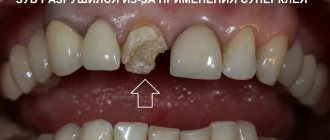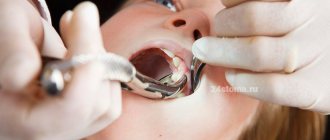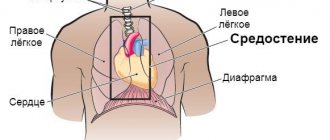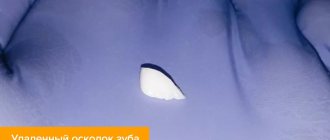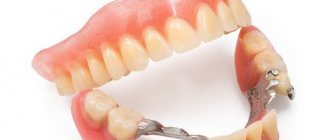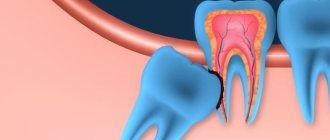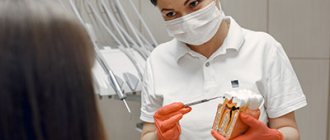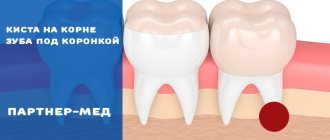01.12.2019
Neglect of oral health leads to various dental diseases with complications. One of them is the overgrowing of the destroyed tooth crown with flesh. Why gums grow in the cavity and how to get rid of this anomaly, we will consider later in the article.
When is a tooth root 100% subject to extraction?
Tooth root removal is performed if:
- the root is softened below the gum level,
- the root of the tooth is below the level of the surrounding bone tissue,
- the root of the tooth has cracks
:
- the root of the tooth is chipped
:
- the root of the tooth is severely damaged, for example as a result of canal treatment with resorcinol
:
- There are various inflammatory processes around the root and under the root of the tooth - cyst, cystogranuloma
:
- the root of the tooth is mobile,
- there is a deep dental pocket.
How is tooth root removal done?
Are there any features or important points when removing a tooth root? Of course, any removal - be it tooth extraction, wisdom tooth removal, impacted tooth or tooth root should be carried out as atraumatically as possible, preserving the tissue structure
that surround a tooth or tooth root:
The goal of atraumatic root removal is to preserve bone
. Removal should be done painlessly.
The clinics of the German Implantology Center are supporters of atraumatic and painless removal. Our technologies have been proven over the years, and our patients feel very comfortable with them. It is no secret that many patients have fears about removal, and these fears sometimes postpone the surgical stage of treatment for a long time. In our clinics, we help patients overcome these fears. The patient may not be afraid of anything - both in the case of a single extraction and in case of multiple extractions of teeth
:
Visit to the dentist without pain
Forget the stress of a botched anesthesia, FDC uses painless pain management techniques.
QuickSleeper is an electronic system that provides simple, fast and comfortable pain relief.
VibraJect is a special attachment. It is an effective way to reduce pain and anxiety during local anesthesia. All this helps reduce patient stress from painful injections and unpleasant visits.
Read more about painless anesthesia with QuickSleeper
What is atraumatic tooth root removal?
What instruments does the surgeon use to achieve atraumaticity? For atraumatic removal, special instruments are used - thin, neat and elastic elevators that can minimally invasively penetrate and expand the periodontal tissue that connects the tooth root directly to the jaw. Using special instruments, the periodontal ligaments are cut so that the root can be removed as carefully as possible, in its “pure form.”
The vestibular plate that surrounds the bone is very thin. And we work with her carefully when removing teeth. It may also be necessary to saw the root of the tooth so that it can be removed in pieces. Sawing can be carried out with oscillating ultrasonic attachments - ultrasonic knives. Cutting the root of a tooth can be done quite effectively with a high-quality thin surgical dental bur, which has a certain length.
After cutting the root, the medial wall of the root is first removed, and then the vestibular wall of the root is removed. This allows for maximum preservation of surrounding tissue.
Then, after such removal, you can preserve the tooth socket or place an implant so that the bone is preserved as much as possible. Preservation of the tooth socket is carried out if there are no conditions for installing an implant at once, or if the patient undergoes delayed implantation.
If the roots of wisdom teeth are removed, the socket is not preserved; it is enough to remove them as atraumatically as possible. Let's talk about this in a little more detail.
Features of root removal of decayed wisdom teeth
Are there any difficulties when removing the roots of wisdom teeth? Removing the roots of wisdom teeth requires that the surgeon has sufficient experience. Often the roots of these third molars (wisdom teeth) are located close to the mandibular canal. Often the roots of molars are adjacent to the upper or lateral wall of the mandibular canal. The configuration of wisdom tooth roots is extremely diverse and sometimes extremely difficult to remove:
Therefore, when removing the roots of wisdom teeth, it is imperative that the patient undergo a CT scan. And the surgeon, as I said, needs to have some experience in surgical training in order to avoid the risks of removing the roots of such teeth and carry out the manipulation as efficiently as possible.
Like any root teeth, the roots of wisdom teeth are removed by cutting them along the roots. Wisdom teeth do not have problems because they are close to the angle of the lower jaw and there are strong cortical plates there. When I talked about thin vestibular walls, this comparison refers to the aesthetic zone of the smile, to the frontal group of teeth, including the premolars:
.
What the patient needs to understand before root removal
You need to assess the health risks, you need to talk to the attending surgeon, find out about his experience. Quite often, tooth root removal is carried out, unfortunately, with the following negative consequences:
- gums are torn
- fractured bony vestibular plate
Sometimes when visiting such patients, you get the feeling that the tooth was not removed, but knocked out with something. There were cases when a patient’s extraction began in some clinic, and there, in the middle of the patient’s appointment, the doctor announced that he was unable to remove it, and the patients came to us in this form to remove the root of a tooth that was already in the extraction stage.
When removing the roots of wisdom teeth, you may face risks such as jaw fracture. One of the common risks of removing the roots of 3 molars is damage to the mandibular nerve
, leading to cuts and numbness in areas of the jaw. There is a risk of damaging the artery on the lingual side.
If, when a tooth is removed, a root or part of it is left behind, what should you do?
According to Russian treatment standards, the tooth root cannot be left during extraction. That is, if the patient was left with a root or part of it during removal, then this is considered a poorly performed surgical procedure.
In European countries there are doctors who agree that if there is no inflammation on the tooth and if the root part is not infected, and removal of the root leads to trauma, then only the cortical part of the root is removed, and the other part remains in the bone.
If the patient is left with a part of the root that is infected, then this is a problem. A cyst may develop and inflammation may develop. If the apical part was not infected, then everything heals and does not bring any trouble to the patient.
Tooth root without crown part
Can a tooth root without a crown cause inflammation in the gums or bone? Of course it can. There is a canal at the root of the tooth; if this canal is infected, then the problem will develop into a negative prognosis.
Inflammation, suppuration, periostitis, osteomyelitis - diseases can develop due to an infected tooth root. And the source of infection at the root must be removed; if it is impossible to remove the infection and preserve the root, then it must be removed.
Hypertrophic pulpitis
Overgrowth of gum tissue is a serious pathology that requires immediate attention to a dental clinic.
The gum comes out of the tooth often with advanced hypertrophic pulpitis, which occurs in two possible chronic forms:
- Excessive volume of soft tissue is formed due to the granulation process. The development of the process is preceded by the presence of a huge carious hole over a long period of time. Due to its presence, soft structures are constantly injured, transmitting irritation to the pulp.
- A dense polyp forms in the pulp area due to the growth and layering of flesh on top.
The disease is mostly asymptomatic. And only eating rough food provokes aching pain. The gums in the problem area may also bleed. But the main sign of hypertrophic pulpitis is the appearance of “wild meat” in the hole of the dental unit. Over time, it grows so much that it fills the entire cavity and goes beyond its limits. Pain and discomfort interfere with proper hygienic care. Aggressive microflora contributes to halitosis (bad breath).
Swelling of the mucous membrane due to traumatic or deep carious destruction of the crown
Gum receding occurs when the walls of the tooth are completely or almost completely destroyed. It becomes inflamed due to constant injury and accumulation of food particles. Plaque thickens over time, puts pressure on the gums, and populates it with pathogenic microflora. The proliferation of aggressive microorganisms contributes to the development of swelling and hyperemia. The gums increase in volume and it seems that meat is sticking out of the cavity of the dental unit. The patient experiences pain and severe burning when eating salty and sour foods. The jaw row reacts sharply not only to taste, but also to temperature stimuli. There is discomfort from hot/cold.
Is implantation possible after tooth root removal?
Yes, of course it is possible. And we at the clinics of the German Implantology Center widely use implantation after tooth root removal. Our conditions allow us to carry out implantation in such cases. And if we can achieve primary stability of the implant, then in 90% of cases
After removal, we immediately install the implant. We have rolled out the technology to perfection and gives excellent results.
Of course, with the exception of wisdom teeth, no implant is placed after their removal. But, by the way, wisdom teeth in this situation can be extremely useful, since they... can be transplanted to the place of the problem tooth being removed! Dental transplantation has been practiced in the clinics of the German Implantology Center since 2017, and our specialists have accumulated a wealth of clinical experience. Let's talk about this a little more.
An alternative to implantation is autotransplantation of wisdom teeth
Don't rush to remove your wisdom teeth. Firstly
, there must be clear indicators for their removal.
Secondly
, you don’t need to follow fashion, trends and delete eights just because “a girlfriend or friend deleted them and it’s cool.” There are a number of moments in life when wisdom teeth come to our aid.
It is not for nothing that nature has created a number of organs that duplicate each other in our body, for example, we have two lungs, two kidneys, which in case of problems with one lung/kidney come to our aid. Also with wisdom teeth: if a person (for some reason) has problems with the chewing group of teeth, for example, caries has destroyed the sixth or seventh tooth, then eights can come to the rescue. How so? After all, wisdom teeth are not involved in the chewing process. Yes, you are right here. But a wisdom tooth can serve as a donor, and it can be transplanted into place of a tooth with destroyed roots. Fantastic? No, advanced technologies in dentistry. This is called autotransplantation.
In the following video we show in detail the dental transplant surgery. The roots of two sixths of the patient's teeth had just been destroyed, and they were replaced by the patient's own wisdom teeth. And, by the way, this patient at the end of the video gives a detailed review after 1 year after the operation. Look, this is useful:
Prerequisites for hyperplasia
The most common factors that can lead to too active cell division include endocrine disorders, as well as hereditary factors. If someone in the family had a similar problem, the child should be checked for pathology as often as possible, even in the absence of any complaints.
It can also be caused by a violation of hygiene rules, as a result of which a large number of pathogenic microorganisms and plaque accumulate on the enamel and under the gums. In addition, when there is a malocclusion, too much pressure may be applied to individual teeth and areas of gum tissue. This leads to poor circulation and injury.
In adults, pathology can develop due to long-term use of certain medications, for example, steroid hormones, drugs against seizures, and potent antidepressants. Tissue proliferation may increase during pregnancy, this is due to changes in hormonal levels at this time. The same situation happens in adolescence. Other reasons: severe lack of vitamins in the body, leukemia.


